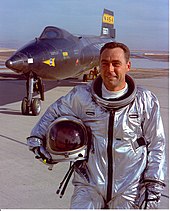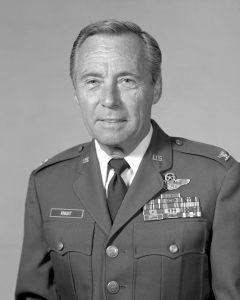19 October 1968 – USAF test pilot Major William “Pete” Knight wins the Harmon international aviator’s trophy for “exceptional individual piloting performance”.
Knight joined the United States Air Force in 1951. While only a second lieutenant, he flew an F-89 at the National Air Show in 1954 and won the Allison Jet Trophy.
 Starting in 1958, following his graduation from both USAF Institute of Technology and the Air Force Experimental Flight Test Pilot School (Class 58C), Knight served as a test pilot at Edwards Air Force Base, California. He was a project test pilot for the F-100 Super Sabre, F-101 Voodoo, F-104 Starfighter, and later, T-38 Talon and F-5 Freedom Fighter test programs. In 1960, he was one of six test pilots selected to fly the X-20 Dyna-Soar, which was slated to become the first winged orbital space vehicle capable of lifting reentries and conventional landings. After the X-20 program was canceled in 1963, he completed the astronaut training curriculum through the Aerospace Research Pilot School (Class 63A) at Edwards AFB and was selected to fly the North American X-15.
Starting in 1958, following his graduation from both USAF Institute of Technology and the Air Force Experimental Flight Test Pilot School (Class 58C), Knight served as a test pilot at Edwards Air Force Base, California. He was a project test pilot for the F-100 Super Sabre, F-101 Voodoo, F-104 Starfighter, and later, T-38 Talon and F-5 Freedom Fighter test programs. In 1960, he was one of six test pilots selected to fly the X-20 Dyna-Soar, which was slated to become the first winged orbital space vehicle capable of lifting reentries and conventional landings. After the X-20 program was canceled in 1963, he completed the astronaut training curriculum through the Aerospace Research Pilot School (Class 63A) at Edwards AFB and was selected to fly the North American X-15.
He had more than his share of eventful flights in the X-15. While climbing through 107,000 feet (33,000 m) at Mach 4.17 on June 29, 1967, he suffered a total electrical failure and all onboard systems shut down. After reaching a maximum altitude of 173,000 feet (53,000 m), he calmly set up a visual approach and, resorting to old-fashioned “seat-of-the-pants” flying, he glided down to a safe emergency landing at Mud Lake, Nevada.[3] For his remarkable feat of airmanship that day, he earned a Distinguished Flying Cross.

On October 3, 1967, Knight set a world aircraft speed record for manned aircraft by piloting the X-15A-2 to 4,520 miles per hour (7,274 km/h) (Mach 6.70)[4][5], a record that still stands today. During 16 flights in the aircraft, Knight also became one of only five pilots to earn their Astronaut Wings by flying an airplane in space, reaching an altitude of 280,500 feet (85,500 m).
After nearly ten years of test flying at Edwards AFB, he went to Southeast Asia in 1968, where he completed a total of 253 combat missions in the F-100 during the Vietnam War. Following his combat tour, he served as test director during the development of the F-15 Eagle at Wright Patterson Air Force Base in Dayton, Ohio. He also was the program director for the International Fighter (F-5) Program at Wright-Patterson. In 1979, he returned to Edwards AFB and served as a test pilot for the F-16 Fighting Falcon.
After 32 years of service and more than 6,000 hours in the cockpits of more than 100 different aircraft, he retired from the U.S. Air Force as a colonel in 1982.
Source: Wikipedia
